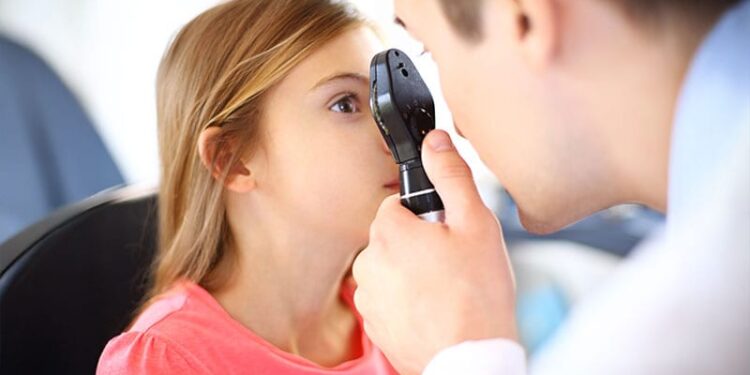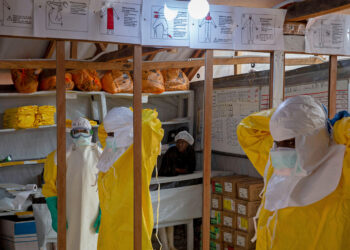As a child, Kathryn Marxen-Simonson often felt embarrassed by her poor eyesight and did not want to stand out from other kids. At school, she wouldn’t use tools like magnifiers that could have helped her.
Today, she is a low-vision therapist and occupational therapist at the Casey Eye Institute at Oregon Health & Science University in Portland, Oregon, and works with children who are in the same situation she was in. Some of her patients exhibit anxiety or depression.
“They might be a little bit more self-conscious about their vision. They don’t want to be different than their peers, right?” said Marxen-Simonson. In high school, she eventually connected with other students with vision issues and started using devices to help her impairment. “I think introducing kids to tools as early as possible is really beneficial, because they get to play around with them and practice, so it’s just kind of part of how they do things.”
But recent data suggested that many children today are not receiving the vision screenings needed to flag potential issues: Those between 6 and 17 years who had their vision tested in the previous 2 years dropped from 84.6% in 2016 to 79.6% in 2023.
The consequences of that decline go beyond not being able to see. Two recent studies found connections between children’s vision and an increased risk for a variety of mental health, learning, and physical health disorders.
Experts say pediatricians and other primary care clinicians can play a role in preventing detrimental health outcomes associated with poor eyesight in children and teens.
Michael Boland, MD, PhD, an associate professor of ophthalmology at the Harvard Medical School in Boston, suggested pediatric practices embed processes to screen patients for visual impairment.
“Checking visual acuity is a good start,” Boland said. “But there are also relatively automated devices now that can do vision screening that look not just for visual acuity, but also strabismus.”
Learning Trouble? Screen Their Vision
Boland and his colleagues recently published a study of children and teens with visual impairment, finding that they were 20% more likely to be diagnosed with depression and 30% more likely to be diagnosed with anxiety than those with normal eyesight. They also had nearly twice the odds of learning difficulties and had issues with peer relationships and hyperactivity/inattention.
And while children with vision problems and severe anxiety or depression often received mental health therapy or special education services, those with more mild or moderate mental health symptoms were far less likely to access such services. Katherine Du, a physician scientist in training at the University of Pittsburgh, Pittsburgh, and lead author of the study, said primary care clinicians can help families get their children connected with school-based paraeducators who support students with vision impairments.
“For primary care physicians, holding an awareness that vision difficulties can impact a child’s mental health is crucial, as early referral to mental health services or school support can impact a child’s long-term well-being,” Du said.
The other study showed children with hearing difficulties had an eightfold increase in the odds of vision loss, while those with difficulty learning, communicating, or making friends had nearly twice the odds of eyesight problems. Those with poor or fair health had double to quadruple the odds of visual impairment compared with children in excellent or very good health.
Radha Kohly, MD, an associate professor in the Department of Ophthalmology and Vision Sciences at the University of Toronto in Toronto, Ontario, Canada, said the siloed nature of healthcare means that connections between vision and other medical issues often go undetected by clinicians.
“People who see children with eye problems may not attend to the psychological and psychosocial aspects. Or people who treat patients with psychosocial problems or mental health issues may not deal with vision problems,” Kohly, an author of the study, said.
Kohly said that when children experience learning difficulties or have issues communicating, pediatricians often attribute these problems to other behavioral issues.
“Instead of quickly going down the ADHD [attention-deficit/hyperactivity disorder] or autism behavioral pathway, make sure on their checklist that they have vision screening,” she said. “People who treat patients with psychosocial problems or mental health issues may not deal with vision problems.”
Primary care clinicians should ensure that their patients who have functional impairments, such as difficulty reading despite wearing glasses or contacts, have been referred to low-vision rehabilitation clinicians. These services can provide kids and their families with additional support to learn about adaptations, modifications, and tools, such as screen readers that tell children what is happening.
Marxen-Simonson said clinicians should work toward identifying children and referring them to supportive tools as early as possible.
“It’s important that families and parents understand that kids who experience vision loss, with the right supports, can go on to be very successful and capable individuals,” Marxen-Simonson said. “And I think that parents benefit from getting support as well.”
Boland, Du, Kohly, and Marxen-Simonson reported having no financial conflicts of interest.
A former pediatrician and disease detective, Ann Thomas is a freelance science writer living in Portland, Oregon.
Source link : https://www.medscape.com/viewarticle/low-vision-high-stakes-kids-slipping-through-cracks-2025a1000hef?src=rss
Author :
Publish date : 2025-06-30 12:05:00
Copyright for syndicated content belongs to the linked Source.









